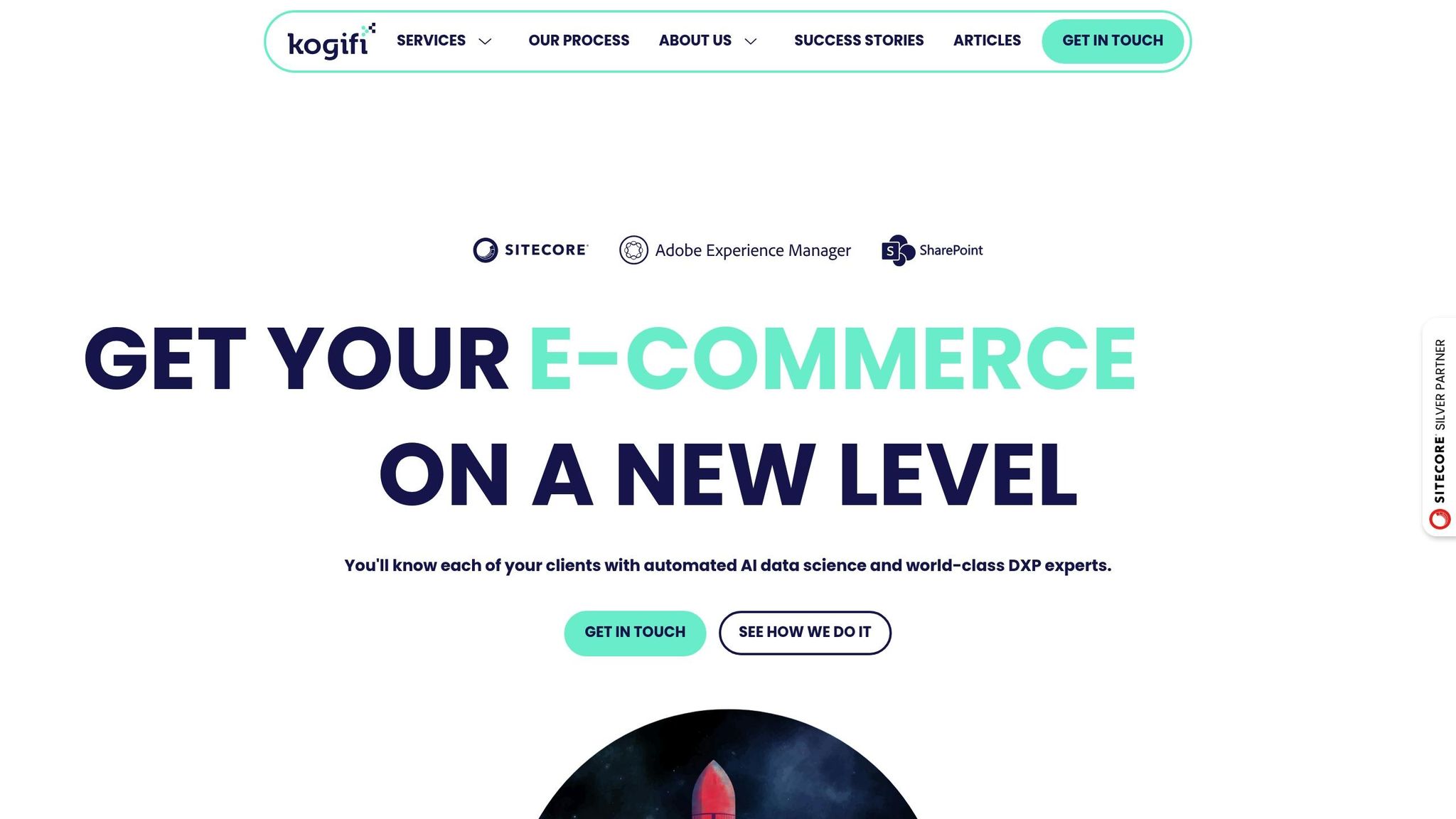Microinteractions are small design elements that improve user experience in e-commerce. They guide users, provide feedback, and make interactions feel intuitive. For example, an animation when adding an item to the cart or real-time form validation builds confidence and reduces friction. These subtle touches can increase conversions, reduce cart abandonment, and make online shopping more engaging.
Key Takeaways:
- Microinteractions include triggers, rules, feedback, and loops.
- They simplify actions like adding items to a cart or validating forms.
- Consistency in design across the platform is essential.
- Animations should be purposeful and brief (under 1 second).
- Platforms like Sitecore and Adobe Experience Manager simplify integration.
- Partnering with experts like Kogifi ensures smooth implementation and optimization.
Microinteractions: Design with Details
Key Areas for Implementing Microinteractions
Microinteractions can significantly enhance the user experience by making key touchpoints more engaging and intuitive. Take the add-to-cart process in e-commerce, for instance - this is one of the most critical moments in a shopper's journey. Well-designed microinteractions here can transform a routine click into a reassuring and satisfying experience, encouraging users to continue exploring.
Enhancing the Add-to-Cart Process
When a user clicks "Add to Cart", subtle yet effective microinteractions can make all the difference. For example, a smooth animation might move the product image toward the cart icon, visually confirming the action. At the same time, the button could briefly change color or slightly enlarge, signaling success and reinforcing the interaction. These small details not only reduce uncertainty but also create a more engaging shopping experience.
Best Practices for Designing Microinteractions
Microinteractions play a key role in shaping a seamless and engaging shopping experience. They help build trust, enhance user engagement, and guide users through their journey. To make the most of microinteractions, it’s essential to design them with a clear purpose, keeping both user needs and business goals in mind.
Focus on Simplicity and Purpose
Each microinteraction should have a well-defined purpose. They need to be simple and intuitive, ensuring users can easily understand their function without feeling overwhelmed or distracted. For instance, a subtle zoom effect when a user hovers over a product image can effectively signal interactivity without drawing unnecessary attention.
Microinteractions should never be added just for decoration. They should provide real value - whether it’s guiding users through tasks, offering feedback, or clarifying system status. Timing is equally important. For example, animations that are too fast may confuse users, while overly slow ones can lead to frustration. Striking the right balance ensures microinteractions enhance the experience rather than detract from it.
Maintain Consistency Across the Platform
Consistency is key to creating a predictable and user-friendly interface. When microinteractions follow a unified design language throughout the platform, users can navigate with confidence. This means using consistent visual styles, animation timing, and behaviors across all interactions.
Take buttons as an example: if the "Add to Cart" button changes color and animates in a specific way when clicked, similar interactions - like "Add to Wishlist" or "Quick View" - should follow the same pattern. This cohesive approach reduces the learning curve for users, reinforces the brand identity, and creates a smoother shopping journey from browsing to checkout.
A consistent design not only enhances usability but also allows microinteractions to feel natural and functional, rather than disjointed or confusing.
Use Functional Animations
Animations should do more than just look good - they need to serve a purpose. Functional animations guide users, provide feedback, and make interactions feel more intuitive. For example, when a user removes an item from their cart, a smooth slide-out animation paired with a confirmation message can reassure them that the action was successful.
Keep animations brief - ideally under one second. Lengthy transitions can make the platform feel sluggish and might even lead to users abandoning their shopping session. Quick, purposeful animations keep the experience engaging and responsive. When designed to mimic real-world actions, they also make digital interactions feel more natural and relatable.
sbb-itb-91124b2
Step-by-Step Process for Designing Microinteractions
Creating effective microinteractions involves a thoughtful, user-centered approach that addresses pain points and enhances the shopping experience. Here's a structured process to guide you through designing them.
Understand User Needs
Start by identifying user pain points through tools like interviews, journey mapping, usability tests, and heat maps. For interviews, talk to 8–10 target customers for about 30 minutes each, asking questions like, "What makes you hesitate before clicking 'Add to Cart'?" or "How do you confirm your payment was successful?" These conversations reveal key friction points.
Next, create a journey map to outline each touchpoint, including emotions and potential frustrations. Usability testing can provide concrete data - ask participants to complete common shopping tasks while verbalizing their thoughts. This helps pinpoint moments of confusion or hesitation.
Heat mapping tools are another valuable resource. They show where users click, scroll, and linger on your pages. Look for areas with frequent interaction but insufficient feedback, or spots where users struggle. These insights highlight where microinteractions can make a real difference.
With this information, you’ll have a solid foundation to begin prototyping.
Design and Test Prototypes
Using the insights gathered, start designing prototypes that define the core elements of your microinteractions: triggers, rules, feedback, and loops. For example, if you’re designing a cart update animation, your trigger might be clicking "Add to Cart", the rules dictate what happens next, the feedback could be a subtle bounce effect on the cart icon, and the loop ensures the cart updates dynamically.
Begin with low-fidelity wireframes to map out how the interaction will flow. Then, use animation-capable design tools to create prototypes that bring these ideas to life.
Testing is essential before moving into full development. Simulate real shopping scenarios and observe how users respond. Do they notice the feedback? Does it clarify what’s happening? A/B testing can help you refine your approach - try two versions of the same interaction, like a color change versus a sliding animation, and compare user responses. Track metrics such as task completion rates, time spent on tasks, or satisfaction scores to determine the most effective design.
Document your decisions and rationale. This record will help maintain consistency across your platform and serve as a reference for future team members.
Iterate and Improve
Once your microinteractions are live, monitor their performance using analytics. Set up event tracking for key actions like button clicks, form submissions, and cart updates. Watch for anomalies that might indicate user confusion or technical issues.
Gather user feedback continuously through in-app widgets, post-purchase surveys, or customer support channels. Regular performance reviews ensure your microinteractions remain smooth and don’t negatively impact site speed.
Schedule periodic evaluations - monthly or quarterly - to analyze feedback, performance data, and business metrics. Use these insights to refine existing microinteractions or introduce new ones as user behavior evolves.
Be mindful of seasonal changes or special events. For example, holiday shopping or sales events might call for temporary adjustments to microinteractions. Plan these updates in advance and test them thoroughly to avoid surprises.
Finally, keep your microinteractions relevant by staying informed about changing user expectations and design trends. Regular updates ensure your site stays modern and continues to provide a seamless shopping experience.
Using Platforms and Expert Services for Microinteraction Design
Creating effective microinteractions for e-commerce requires both a strong technical foundation and expert guidance. By combining best practices in microinteraction design with powerful enterprise platforms, businesses can streamline implementation and deliver a seamless user experience.
Leveraging Enterprise Platforms for Integration
Platforms like Sitecore, Adobe Experience Manager, and SharePoint simplify the integration of microinteractions, offering built-in tools and features that reduce the need for custom development. These platforms come equipped with components and animation libraries that save time and minimize complexity.
For example, Sitecore's Experience Editor allows marketers to design and tweak microinteractions without requiring extensive technical expertise. Its personalization engine can trigger specific microinteractions based on user behavior, location, or purchase history. A returning customer might see a unique "add-to-cart" animation, tailored to their previous interactions, compared to a first-time visitor.
Adobe Experience Manager stands out for managing intricate content workflows while supporting dynamic microinteractions. Its integration with Adobe's Creative Suite enables designers to craft detailed animations and deploy them effortlessly across the platform. Additionally, its analytics tools track user engagement with these interactions, offering valuable insights to fine-tune performance.
Although traditionally associated with internal business applications, SharePoint has evolved to support customer-facing e-commerce needs. It excels in managing complex product catalogs and inventory systems while ensuring smooth, engaging user interactions throughout the shopping journey.
These platforms handle the heavy lifting on the backend, allowing businesses to focus on delivering exceptional user experiences. They also offer scalability to handle peak sales periods, ensuring microinteractions perform reliably even during high-traffic events.
Collaborating with Experts Like Kogifi

While platforms simplify the technical side of microinteraction integration, partnering with experts like Kogifi can elevate the overall experience. With their technical expertise and strategic approach, they combine platform knowledge with advanced UX/UI design skills.
Kogifi offers end-to-end support, starting with platform audits to identify areas where microinteractions can improve user engagement. They also provide 24/7 support, ensuring that your microinteractions remain effective and glitch-free - an essential service in the fast-paced world of e-commerce, where even minor issues can impact sales.
Their expertise is particularly valuable when integrating microinteractions with systems like inventory management, payment processing, and CRM tools. By ensuring seamless functionality across these systems, they prevent performance issues that might disrupt the user experience.
Kogifi also specializes in AI-driven personalization and omnichannel strategies, enabling microinteractions to adapt to user preferences and maintain consistency across devices. Whether customers are shopping on a desktop, mobile device, or another channel, the experience remains cohesive and engaging. Developing this level of sophistication internally would require significant resources.
Additionally, Kogifi provides in-depth traffic analysis to optimize microinteractions. They can pinpoint which interactions drive conversions, identify areas of friction, and analyze how different customer segments respond to various designs. These insights help refine microinteractions to achieve better business outcomes.
Their migration and upgrade services ensure that your microinteractions stay up-to-date with platform advancements. As e-commerce technology evolves, maintaining effective microinteractions means keeping pace with new features and updates.
Conclusion: Key Takeaways
Microinteractions might be small, but their impact on e-commerce is anything but minor. These subtle animations and feedback mechanisms can turn an ordinary shopping experience into something intuitive and engaging.
By understanding what your users need and identifying areas where small tweaks can make a big difference, you can create a smoother, more enjoyable journey. For instance, hover effects and image transitions make product exploration more interactive, while clear validation messages can guide users seamlessly through the checkout process.
The key to successful microinteractions lies in simplicity and consistency. They should feel natural, enhancing the experience without being distracting. Animations that serve a functional purpose will always outperform flashy effects that exist purely for show.
On the technical side, seamless integration is critical. Enterprise platforms like Sitecore, Adobe Experience Manager, and SharePoint make it easier to incorporate microinteractions while allowing for the necessary customization. Working with experts like Kogifi can elevate your implementation, ensuring smooth integration with existing systems, ongoing optimization, and consistent performance across all channels. Their combination of platform knowledge, UX/UI expertise, and strategic insight can transform a good design into an outstanding one.
Ultimately, well-executed microinteractions can drive user engagement, boost conversions, and build customer loyalty. In a competitive market, these small details often make the difference between a completed purchase and an abandoned cart. Focus on what matters most to your users, prioritize function over flash, and partner with specialists when needed to ensure your microinteractions truly shine.
FAQs
How do microinteractions help reduce cart abandonment in e-commerce?
Microinteractions play a key role in making the checkout process more user-friendly, which can significantly cut down on cart abandonment. These tiny design touches - like confirming when an item is added to the cart or displaying progress during checkout - offer real-time feedback that reassures shoppers their actions are being handled correctly.
They also help tackle common frustrations by providing gentle reminders for unfinished tasks, such as completing payment details or using available discounts. By streamlining the experience and keeping it engaging, microinteractions ease potential stress, build trust, and encourage more customers to follow through with their purchases.
What are the best practices for creating consistent microinteractions across an e-commerce platform?
To ensure your e-commerce platform offers a cohesive experience, start by creating a unified style guide. This guide should detail the visual elements, animations, and interaction behaviors that reflect your brand identity. By doing so, every microinteraction will feel consistent and aligned with your overall design.
Keep microinteractions simple, purposeful, and easy to understand. They should serve a clear function, adding value without distracting or confusing users. For example, use animations or visual cues to provide immediate feedback, helping users see the results of their actions instantly.
Finally, maintain consistent interaction patterns throughout your platform. Using the same animations, timing, and triggers across the site helps users build familiarity. This consistency not only makes navigation smoother but also fosters trust, creating a more enjoyable shopping experience.
How can working with experts like Kogifi improve microinteractions in e-commerce?
Collaborating with experts like Kogifi can elevate the design and functionality of microinteractions in your e-commerce platform. With their deep knowledge of digital experience platforms (DXPs) and enterprise CMS solutions, they ensure these subtle yet impactful elements are seamlessly woven into your website or app, enhancing the overall user journey.
Kogifi’s expertise also extends to UX/UI design and AI-powered personalization, enabling them to craft microinteractions that align with customer preferences and drive higher conversions. Their commitment to ongoing support and their ability to respond to evolving user behaviors ensure your e-commerce platform remains competitive, delivering tangible benefits for your business.








































